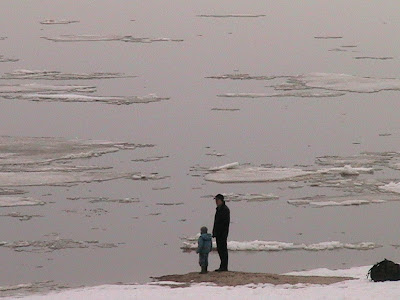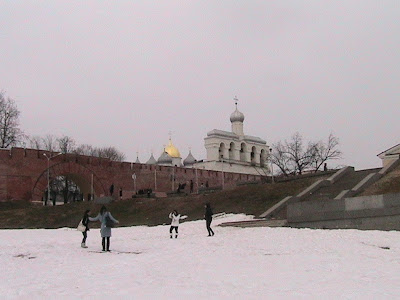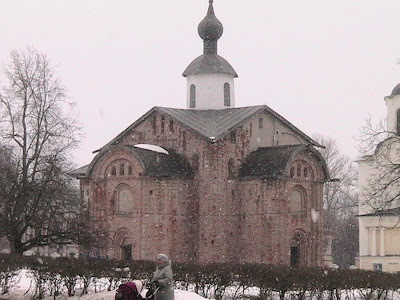It was an extremely lively bus ride.
Since Saint Petersburg is a Russian city trying to be a European city, at this point in a way we still hadn't really entered Russia yet. And so I was extremely excited to be going to Veliky Novgorod, which is about as Russian a city as you can get. It is one of the oldest cities in Russia, and is extremely historically significant. But more on that later.
After a three-hour drive we finally caught sight of some old-looking church domes, so we knew we had arrived.
By the way, Veliky Novgorod means "Great Novgorod". Not to be confused with Nishny Novgorod ("Lower Novgorod"), which isn't as old.
The modern city of Veliky Novgorod is not doing well. Its economy is struggling and what we saw of it looked pretty run-down, which was really sad, particularly considering the city's history. We didn't spend any time in the modern section but continued on to the historical part of Novgorod.
This is the Novgorod Kremlin, which surrounds most of the old part of the city. People tend to think of the Kremlin in Moscow as being THE kremlin, but the word simply means "fortress" in Russian. All old cities had a kremlin to keep out invaders.
Look! Snow! Ahahahaha! I love how I had to go to Russia to get some decent snow. Jeez, Denmark.
Just inside the entrance to the kremlin was this WWII memorial. WWII was a particularly horrific war for Russia. More than 25 million (think about that for a minute) Soviet citizens were killed- most of them civilians- and the battles fought on Soviet soil were some of the most brutal battles of the war. Because of this, many Russian cities have WWII memorials, particularly the ones (like Veliky Novgorod) that were directly affected by the fighting.
Most Russian WWII memorials have eternal flames like this.
Okay, I've delayed enough. Time for some history. Once upon a time (about 1,200 years ago, in fact) the country of Russia did not exist. What did exist in the huge mass of forests and steppes east of Europe were many individual tribes of people, who didn't interact much because there was a whole lot of forest separating them and it really wasn't worth the bother. Ancient Russia was a bit like Ancient Greece in this respect, though in Greece the problem was mountains. Anyway, these people were fairly successful. They were surviving and developing. And then, all of a sudden, a bunch of warlike foreigners arrived.
...Meanwhile, in Scandinavia (That's right. It all comes full circle. I did that on purpose) there were a bunch of very awesome people called Vikings, who I'm sure you've heard of. They traveled all over the world sacking and pillaging and generally having a good time. And then one day some Swedish Vikings realized how great it would be to sack the extremely rich city of Constantinople. There was only one problem with this plan. By a horribly inconvenient trick of geography, getting to Constantinople from Scandinavia involved sailing all the way around Europe and down past Africa and the Mediterranean. Well, a journey like that could put anyone off, but then the Swedish Vikings made a remarkable discovery. They realized that just to the east, in that big mass of trees and more trees that no one in Europe had really bothered with before, there were a bunch of rivers, all of which ran north-south. And they realized that they could use these rivers to sail straight on down to the Black Sea and Constantinople, with only a brief stop in the middle where they would have to lug their boats out of one river and into another. Brilliant!
So they headed east and started gleefully coasting right down the rivers and sacking Constantinople. And it wasn't too long before they started establishing settlements along the rivers, because that meant they didn't have to go all the way back up to Sweden after sacking Constantinople. Before too long these settlements grew into larger cities, and the Swedish Vikings started to have a huge impact on the land around them. They interacted with the local tribes (which mostly- but not always- included pillaging) and brought new, Scandinavian influences to the area. They provided the area with a name (because the Vikings were referred to as the "Rus" and so, therefore...) And, most importantly, they brought a guy named Riurik who became the founder of the Riurik dynasty- Russia's first royal family.
So basically, the Vikings ended up being the founders of the country that would become Russia. While Russians have debated the exact degree of Viking influence in their country's beginnings for years, it is undeniable that it might have taken Russia a bit longer to develop had it not been for the Vikings showing up. Scandinavia saves the day again.
And remember those Viking river settlements I mentioned? Two of them grew up to be the southern and northern capitals of the new country. The southern was Kiev (now the capital of Ukraine) and the northern was... you guessed it... Veliky Novgorod.
As I mentioned, it's a very old and important city. Now you know.
This is the Cathedral of Saint Sophia, the oldest cathedral in Russia and one of the central features of the Veliky Novgorod kremlin. It is a very, very typical Russian-style cathedral, with lots of domes and very small windows. The fact that it is white is also typical for northern Russia. My teacher told us that in the north the color scheme is white-based and in the south it's red-based (e.g. St. Basil's Cathedral in Moscow- which you'll see later).
We weren't allowed to take pictures inside the cathedral, but it was really cool. There seemed to be an endless number of little rooms with icons, and the walls were all painted with religious figures and designs. One of the typical features of a Russian Orthodox Church is an iconostasis, which is basically a huge ornate wall with icons on it, that creates something like a backstage area where the priests can get ready for services. The iconostasis in the Cathedral of Saint Sophia was one of the tallest I have ever seen. It reached almost to the ceiling, which was itself pretty darn tall. It was very dark in the cathedral, mostly because the wall paintings followed a dark color scheme and because there wasn't a lot of lighting, for reasons of preservation.
This is the Volkhov River, which separates the two halves of the old city of Veliky Novgorod. This was one of those instances on the trip, as I stood there in the snow, watching the ice float by on the river and looking at the trees and the churches across the water and breathing in the chilly air, where I truly appreciated the fact that I was actually, for real, not just imagining it, IN RUSSIA. And the fact that this place was so old and vital to the birth of Russia as a nation just made it all the more powerful to be there.
Eeep!
I think my classmates were just as happy about the snow as I was.
Just in case we forgot where we were...
Then we went across the river to look at the business district of the old city, which mostly consisted of more churches because all of the guilds in the city had wanted their own church. It was cool to see how much variety of design there was.
It snowed for a few minutes. I was really happy.
We had lunch in a funny little brick restaurant. The food was really good. This was some kind of salmon salad thing. With a plant on top.
Meat and vegetable soup. I had more meat and vegetable soup in Russia than I'd had before in my entire life. It was really good, though, so I didn't mind.
Fish and potatoes.
Ice cream!
After lunch we went to visit a little monastery nearby. It was run by one monk, who we got to talk to about religion in Russia.
Okay, I think it's about time for a lecture on Russian Orthodox Christianity, which is (and has been for hundreds of years, with only a 74 year gap between 1917 and 1991) Russia's official state religion. The story goes that in 988 Vladimir I, the Grand Prince of Kiev (and thereby the ruler of the country that would become Russia) brought Christianity over with him from abroad. What had happened was that the year before he had gone traveling. He realized that the area needed one unifying factor so that it could become an actual country and (more importantly) completely fall under his control. And he decided that religion was the way to do it. The story says that he traveled all over- he visited the Muslims, but he didn't like their religion because it forbade drinking alcohol. He visited the Jews but their religion worried him because they didn't even have their own country. And then he went to Constantinople and was blown away by how shiny and awesome it was, so he decided on Orthodox Christianity. It is likely that this story is not in fact true, but it sounds good and is mildly entertaining so it works just as well. Anyway, Vladimir I denounced the pagan religion that was worshipped by his subjects and forced them all to get baptized. And thus christianity came to Russia.
Russian Orthodox Christianity is different from most other forms of christianity in that it is very, very traditional. And I realize that that's saying something. It's big justification for claiming to be the one true religion is that it goes exactly by the book and has never once changed its traditions, unlike those wishy-washy heretical Catholics. Hmph.
They stand up in church (there are no pews in Russian Orthodox cathedrals) and cross themselves using three fingers, unlike in other forms of christianity where, apparently, they use two. The cross most commonly used is a three-armed cross, like this:
This cross is actually more historically accurate than the other, more typical christian cross. The upper, little crosspiece represents the placard that the Romans used to stick on the crosses telling what the crucified person's crime was. And the bottom crosspiece represents a crooked foot rest.
The monk was very interesting to talk with. He told us that the low level of religious faith in modern Russia worried him, and said that he didn't think it made sense to not be religious. After all, when the end of the world comes it's better to be prepared, right? While this is obviously not a view that I share, it was still intriguing listening to a very religious person discuss their views on the world. It's not a chance that I would normally have.
After our visit to the monastery we headed over to the train station, and got on an overnight train for the trip to our last destination: Moscow. I had never been on an overnight train before, and it was really cool. We were separated off into little four-person compartments, then were free to go off an explore the train. One of the coolest things was the dining car, which was made to look like an old diner.
The train pulled out of the station at 9:00, and I spend quite a while with my nose glued to the window, watching the landscape pass by as the sun set. It was an eight hour trip, so we were scheduled to arrive in Moscow at 5:00 in the morning. With this in mind, we all went to bed early. None of us got a ton of sleep, but I slept quite well considering. And just the fact that I was spending the night on a Russian sleeper train and would wake up in Moscow made whatever exhaustion I knew I would end up with in the morning completely worth it.
So, the next post should be the last one about Russia. Jeez, I still have so much to talk about! Hopefully I'll have time. Onward to Moscow!
Пока!





























Emma that plant is called Parsley. You need to learn your herbs. Love your historic information - very entertaining.
ReplyDeleteParsley. Right. That thing. Let's just say the historical information is taking up the brain space normally reserved for herbs.
ReplyDeleteTouché
ReplyDeleteWe will have an herbal review quiz when you return home.
ReplyDeleteOkay. Sounds like fun.
ReplyDeleteHi Emma,
ReplyDeleteParsley....forget about Parsley. Did you happen to spend any Thyme with Rosemary? I heard she gives Sage advice.
I am looking forward to seeing you soon and hearing all your wonderful stories in person.
Have a safe journey home.
Pete